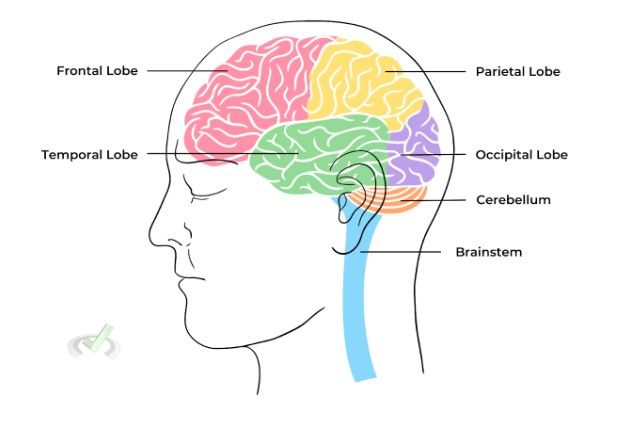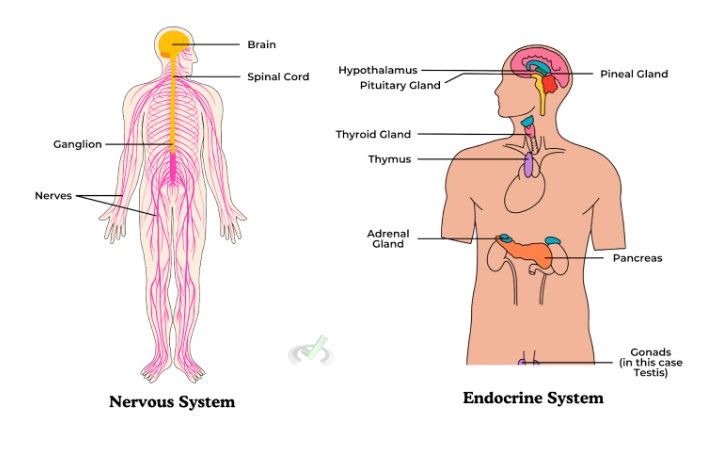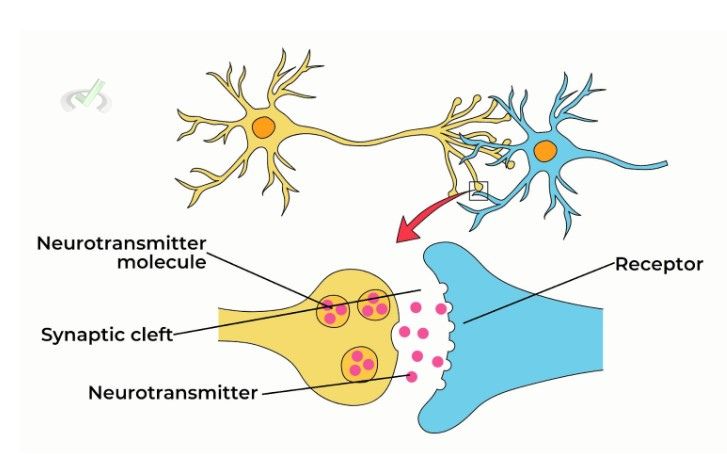Imagine you hear a sudden loud noise. You turn your head towards the sound without even thinking.
Your nervous system causes this quick reaction. It controls everything from basic reflexes to complex thoughts and emotions.
The nervous system is the body's main control center. It has two main parts, namely the central nervous system (CNS) and also the peripheral nervous system (PNS).
Understanding these parts helps us know how our bodies process information and respond to our environment. Let's explore the structures and functions of this system.
I. Central Nervous System (CNS)
Your brain and the spinal cord comprise the CNS. It is the body's decision-making center, processing information and issuing commands.
A. Brain

The brain is divided into various parts, each with specific roles:
Cerebrum: The largest part of the brain. It handles voluntary activities, sensory perception, and thinking. It is divided into four lobes:
Frontal Lobe: Controls thinking, planning, and voluntary movement.
Parietal Lobe: Processes sensory information like touch, temperature, and pain.
Temporal Lobe: Involved in hearing and memory.
Occipital Lobe: Responsible for vision.
Cerebellum: Responsible for balance and coordination. It ensures smooth and precise movements.
Brainstem: Controls automatic functions like breathing and heart rate.
The skull protects the brain. Cerebrospinal fluid cushions it and helps absorb shocks and protect it from impacts.
Additionally, three layers of membranes surround the brain for extra protection. These are called meninges (dura mater, arachnoid mater, and pia mater),
B. Spinal Cord
The spinal cord is composed of a long, thin bundle of nerves. It runs from the brain down the spine. Moreover, it acts as the main communication highway. The spinal cord also transmits signals between the brain and the rest of the body.
The spinal cord also manages simple reflexes, such as pulling your hand away from a hot surface. This rapid response happens here for immediate action.
II. Peripheral Nervous System (PNS)
The PNS connects the CNS to the rest of the body. It is divided into two main systems: the somatic nervous system and the autonomic nervous system.
A. Somatic Nervous System
Your body’s somatic nervous system controls voluntary movements. It includes nerves that link the CNS to muscles and sensory organs.
For example, you decide to pick up a book. Your brain sends a signal through the somatic system to the muscles in your hand.
B. Autonomic Nervous System

The autonomic nervous system manages involuntary functions like heart rate and digestion. It has two divisions:
I. Sympathetic Nervous System
Prepares the body for action. This is known as the fight or flight response. It increases heart rate and energy levels.
II. Parasympathetic Nervous System
Helps your body relax and save energy. This is known as the rest and digest response. It slows down the heart rate and promotes digestion.
III. Neurons: Building Blocks of the Nervous System
The nervous system is composed of very specialized cells called neurons. Neurons communicate through electrical and chemical signals.
A. Structure of Neurons
Each neuron consists of three main parts:
- Cell Body: Contains the nucleus, which processes information.
- Dendrites: Branch-like structures where signals are received from other neurons.
- Axon: A long fiber that sends signals to other neurons, muscles, or glands.

There are three main types of neurons:
- Sensory Neurons: Carry information from sensory organs to the CNS.
- Motor Neurons: Transmit instructions from the CNS to muscles and glands.
- Interneurons: Connect neurons within the CNS, facilitating internal communication and processing.
B. Glial Cells
Glial cells support and protect neurons. They provide nutrients, maintain the extracellular environment, and help repair damage. There are different types of glial cells: astrocytes, oligodendrocytes, and microglia.
IV. How Neurons Communicate
Neurons communicate at junctions called synapses. When a signal reaches the end of an axon, it releases chemicals known as neurotransmitters.
These neurotransmitters cross the synapse. Then, they attach to receptors on the next neuron, continuing the signal. This precise signalling ensures messages are transmitted throughout the body.
Examples of Neurotransmitters
- Dopamine: Involved in movement, emotion, and the reward system.
- Serotonin: Affects mood, appetite, and sleep.
- Acetylcholine: Responsible for muscle action and memory.
V. Key Functions of the Nervous System
The nervous system performs several critical functions:
- Sensory Input: Gathering information about the environment from sensory organs.
- Integration: Processing and interpreting this sensory input.
- Motor Output: Sending instructions to muscles and glands to take action.
A. Reflex Arc
A reflex arc is a simple nerve pathway responsible for reflex actions. It involves a sensory neuron, an interneuron in the spinal cord, and a motor neuron. For example, the reflex that makes you pull your hand away from a hot object is a reflex arc in action.
VI. Disorders of the Nervous System
Grasping the structure and function of the nervous system helps us identify and treat its disorders. Some common disorders include:
- Alzheimer's Disease: A progressive condition that impairs memory and cognitive function.
- Parkinson's Disease: A disorder affecting movement and coordination.
- Multiple Sclerosis: A disease where a person’s immune system attacks the protective covering of nerves.
Early diagnosis and treatment are crucial for managing these conditions and improving the quality of life.
VII. Interactions with Other Systems
The nervous system interacts closely with several other systems in the body. Understanding these interactions is crucial to understanding how the body functions.
A. Nervous and Endocrine Systems

The nervous system works with the endocrine system to maintain homeostasis. The hypothalamus, part of the brain, controls the body’s pituitary gland.
The pituitary gland then regulates various hormonal functions throughout the body. This interaction is crucial for growth, metabolism, and stress response.
B. Nervous System and Mental Health
Neurotransmitter imbalances are often linked to psychological disorders. This is a crucial topic in MCAT's psychology and sociology sections. For example, low levels of serotonin are directly connected with depression.
Dopamine imbalances are linked to schizophrenia and Parkinson's disease. Understanding these connections highlights the importance of neurobiology in mental health.
C. Nervous and Cardiovascular Systems
The autonomic nervous system regulates your cardiovascular system. Meanwhile, the sympathetic nervous system increases heart rate and blood pressure during stress.
The parasympathetic nervous system helps to lower them during relaxation. This interaction is vital for maintaining cardiovascular health and is significant in biology.
VIII. Wrap-Up and Key Terms
A. Central Nervous System (CNS)
The CNS includes the brain and spinal cord. The brain handles voluntary and involuntary activities. Meanwhile, the spinal cord sends signals between the brain and body and controls reflexes.
B. Peripheral Nervous System (PNS)
The PNS connects the CNS to the body. It includes the somatic system for voluntary movements and the autonomic system for involuntary functions. The autonomic system is divided into the sympathetic (fight or flight) and parasympathetic (rest and digest) systems.
C. Neurons
Neurons are the building blocks of your body’s nervous system. They have a cell body, dendrites, and an axon. Neurons communicate through synapses using neurotransmitters.
D. Glial Cells
Glial cells support and protect neurons. Types include astrocytes, oligodendrocytes, and microglia.
E. Key Functions
The crucial functions of the nervous system include sensory input, integration, and motor output. Sensory input collects information, integration processes it, and motor output sends instructions to muscles and glands.
F. Disorders
Common nervous system disorders are Alzheimer's, Parkinson's, and multiple sclerosis. Early diagnosis and treatment are essential in order to manage these conditions.
IX. Practice Questions
Sample Practice Question 1
Complete the following statement: The part of the brain that is responsible for coordinating muscle movements and maintaining balance is the __________.
A. Cerebrum
B. Cerebellum
C. Brainstem
D. Spinal cord
Ans. B
The cerebellum coordinates muscle movements and helps maintain balance.
Sample Practice Question 2
Which part of the autonomic nervous system prepares the body for action in a fight or flight response?
A. Sympathetic Nervous System
B. Parasympathetic Nervous System
C. Somatic Nervous System
D. Central Nervous System
Ans. A
The sympathetic nervous system triggers the fight-or-flight response. It increases heart rate and energy levels.








 To help you achieve your goal MCAT score, we take turns hosting these
To help you achieve your goal MCAT score, we take turns hosting these 





















 reviews on TrustPilot
reviews on TrustPilot